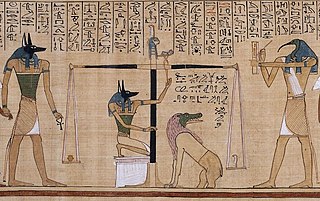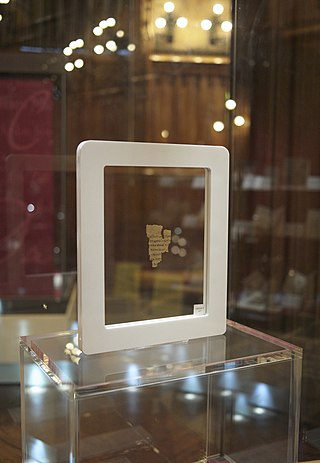
The Book of the Dead is an ancient Egyptian funerary text generally written on papyrus and used from the beginning of the New Kingdom to around 50 BC. The original Egyptian name for the text, transliterated r(ꜣ)w n(y)w prt m hrw(w), is translated as Book of Coming Forth by Day or Book of Emerging Forth into the Light. "Book" is the closest term to describe the loose collection of texts consisting of a number of magic spells intended to assist a dead person's journey through the Duat, or underworld, and into the afterlife and written by many priests over a period of about 1,000 years. Karl Richard Lepsius introduced for these texts the German name Todtenbuch, translated to English as Book of the Dead.

The Elephantine Papyri and Ostraca consist of thousands of documents from the Egyptian border fortresses of Elephantine and Aswan, which yielded hundreds of papyri and ostraca in hieratic and demotic Egyptian, Aramaic, Koine Greek, Latin and Coptic, spanning a period of 100 years in the 5th to 4th centuries BCE. The documents include letters and legal contracts from family and other archives, and are thus an invaluable source of knowledge for scholars of varied disciplines such as epistolography, law, society, religion, language and onomastics. The Elephantine documents include letters and legal contracts from family and other archives: divorce documents, the manumission of slaves, and other business. The dry soil of Upper Egypt preserved the documents.

Neferkare Setepenre Ramesses IX was the eighth pharaoh of the Twentieth Dynasty of Egypt. He was the third longest serving king of this Dynasty after Ramesses III and Ramesses XI. He is now believed to have assumed the throne on I Akhet day 21 based on evidence presented by Jürgen von Beckerath in a 1984 GM article. According to Papyrus Turin 1932+1939, Ramesses IX enjoyed a reign of 18 years and 4 months and died in his 19th Year in the first month of Peret between day 17 and 27. His throne name, Neferkare Setepenre, means "Beautiful Is The Soul of Re, Chosen of Re." Ramesses IX is believed to be the son of Mentuherkhepeshef, a son of Ramesses III, since Mentuherkhopshef's wife, the lady Takhat bears the prominent title of King's Mother on the walls of tomb KV10, which she usurped and reused in the late 20th Dynasty; no other 20th Dynasty king is known to have had a mother with this name. Ramesses IX was, therefore, probably a grandson of Ramesses III.

The Rylands Library Papyrus P52, also known as the St John's fragment and with an accession reference of Papyrus Rylands Greek 457, is a fragment from a papyrus codex, measuring only 3.5 by 2.5 inches at its widest, and conserved with the Rylands Papyri at the John Rylands University Library Manchester, UK. The front (recto) contains parts of seven lines from the Gospel of John 18:31–33, in Greek, and the back (verso) contains parts of seven lines from verses 37–38. Since 2007, the papyrus has been on permanent display in the library's Deansgate building.

Menmaatre Ramesses XI reigned from 1107 BC to 1078 BC or 1077 BC and was the tenth and final pharaoh of the Twentieth Dynasty of Egypt and as such, was the last king of the New Kingdom period. He ruled Egypt for at least 29 years although some Egyptologists think he could have ruled for as long as 30. The latter figure would be up to 2 years beyond this king's highest known date of Year 10 of the Whm Mswt era or Year 28 of his reign. One scholar, Ad Thijs, has suggested that Ramesses XI could even have reigned as long as 33 years.
The system of ancient Egyptian numerals was used in Ancient Egypt from around 3000 BCE until the early first millennium CE. It was a system of numeration based on multiples of ten, often rounded off to the higher power, written in hieroglyphs. The Egyptians had no concept of a place-valued system such as the decimal system. The hieratic form of numerals stressed an exact finite series notation, ciphered one-to-one onto the Egyptian alphabet.

The Story of Wenamun is a literary text written in hieratic in the Late Egyptian language. It is only known from one incomplete copy discovered in 1890 at al-Hibah, Egypt, and subsequently purchased in 1891 in Cairo by the Russian Egyptologist Vladimir Golenishchev. It was found in a jar together with the Onomasticon of Amenope and the Tale of Woe.

Piankh was a High Priest of Amun during the 21st Dynasty.

Vladimir Semyonovich Golenishchev, formerly also known as Wladimir or Woldemar Golenischeff, was one of the first and most accomplished Russian Egyptologists.
The period of ancient Egyptian history known as wehem mesut or, more commonly, Whm Mswt can be literally translated as Repetition of Births, but is usually referred to as the (Era of the) Renaissance.

Pinehesy, Panehesy or Panehasy, depending on the transliteration, was Viceroy of Kush during the reign of Ramesses XI, the last king of the Egyptian 20th Dynasty.
The Mayer Papyri are two ancient Egyptian documents from the Twentieth Dynasty that contain records of court proceedings.

Ancient Egyptian literature was written in the Egyptian language from ancient Egypt's pharaonic period until the end of Roman domination. It represents the oldest corpus of Egyptian literature. Along with Sumerian literature, it is considered the world's earliest literature.

Amenhotep was the High Priest of Amun towards the end of the Twentieth Dynasty of Egypt, serving under Ramesses IX, Ramesses X and Ramesses XI. He was the son of Ramessesnakht, the previous high priest of Amun. It is not beyond dispute who succeeded him in office. For a long time it was assumed that he was followed by the High Priest Herihor. However, Karl Jansen-Winkeln has suggested that Amenhotep was instead succeeded by the High Priest Piankh. We know the names of several of his brothers and a sister:
Papyrus Oxyrhynchus 216 is a rhetorical exercise by an unknown author, written in Greek. It was discovered in Oxyrhynchus. The manuscript was written on papyrus in the form of a roll. It is dated to the first century BC or first century AD. Currently it is housed in the Beinecke Rare Book and Manuscript Library (35) of the Yale University.

The Gospel of Jesus' Wife is a likely-forged papyrus fragment with Coptic text that includes the words, "Jesus said to them, 'my wife...'". The text received widespread attention when first publicized in 2012 for the implication that some early Christians believed that Jesus was married.

Alexander Militarev is a Russian scholar of Semitic, Berber, Canarian and Afroasiatic languages, comparative-historical linguistics, Jewish and Bible studies at the Russian State University for the Humanities.

Rus' chronicle or Russian chronicle or Rus' letopis was the primary type of Rus' historical literature. Chronicles were composed from 11th to 18th centuries, generally written in Old East Slavic about Kievan Rus' and subsequent Rus' principalities and histories. Chronicles were one of the leading genres of Old Rus' literature, and were prominent in medieval and early modern Eastern and Central Europe.

Muhadin Ismailovich Kishev is a Circassian artist from Kabardino-Balkaria in the North Caucasus. His art is concerned with the confirmation of beauty and the medium of his paintings is usually oil on canvas or monotype on paper, with colour as the protagonist of his art. Kishev has exhibited his work in many countries apart from Russia including England, Spain and the United States. Currently he lives in Spain and divides his time between his Studios in Moscow, Nalchik and Los Canyos de Meca in Andalusia.

"The House with the Mezzanine" is an 1896 short story by Anton Chekhov, subtitled "An Artist's Story".
















